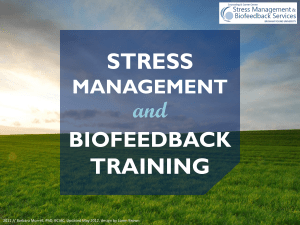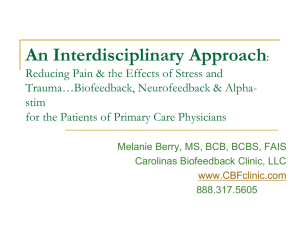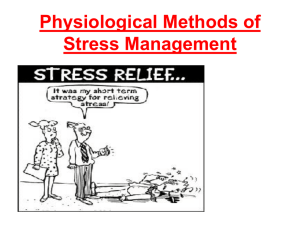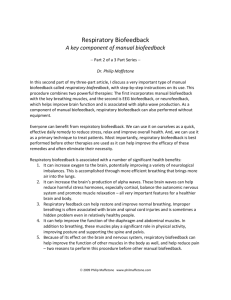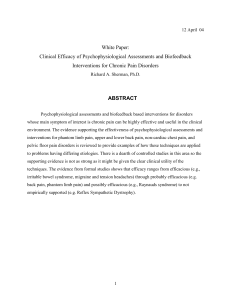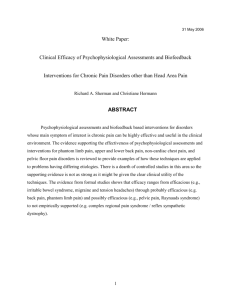Respiratory Biofeedback
advertisement
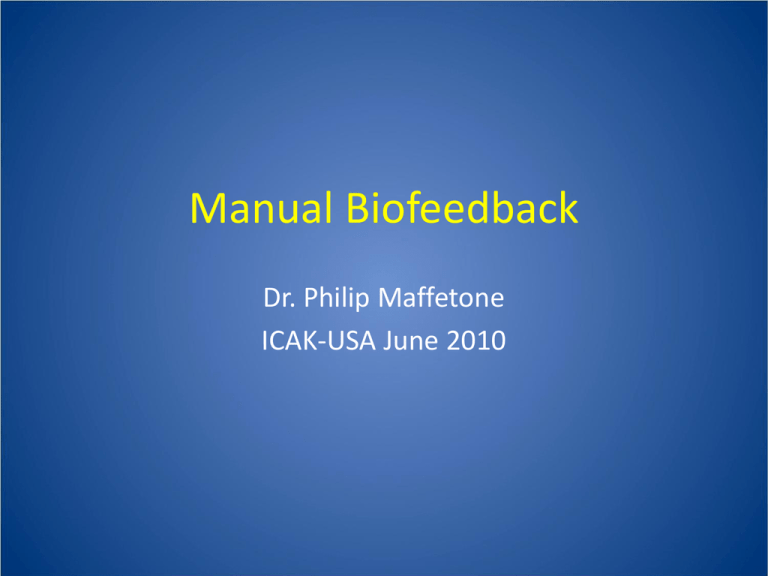
Manual Biofeedback Dr. Philip Maffetone ICAK-USA June 2010 Manual Biofeedback • Addresses the full spectrum of neuromuscular function: brain, spinal cord and muscle. • Combines EMG- and EEG-type biofeedback. • Both a basic and advanced procedure. – Knowledge of MMT allows immediate use of manual biofeedback. – Addresses clinically difficult cases; i.e., muscles with zero contraction (stroke, brain injury, etc.). • Can help improve the performance of “normal” muscles. Manual biofeedback addresses the full spectrum of muscle function MUSCLE FUNCTION SCALE: 0 – 5 (Kendall) 0 – No contraction 1 – Trace of muscle movement, but no limb or joint movement. 2 – Minimal movement but not against gravity. 3 – Movement against gravity but not against resistance by the examiner. 4 – Movement against minimal resistance by the examiner. 5 – Movement against resistance (“normal”). Manual Biofeedback References – – – – – Dr. George Goodheart (AK); Dr. John Thie (ICAK); Dr. Patricia Cowins (NASA); Dr. Bernard Brucker (University of Miami); Dr. Coralee Thompson (former Medical Director, The Institutes); – Dr. Diane Damiano (Washington University); – Many others. Manual Biofeedback Goals: • Enhance neural plasticity: The stimulation or recruitment of unused or underused synapses for improved motor control; • Implement active (vs. passive) therapy and patient participation (“task-oriented” vs. “static”); • Improve physical movement – one fiber at a time. Movement… ...is a powerful therapy in itself: from improved posture and gait to better brain function, including speech, vision, balance, memory and even intellect. Muscle movement – even contraction of a single muscle – releases myokines (a cytokine) Brain Liver Muscles Fat cells A model to explain the muscle-organ relationship? Manual Biofeedback (MB) vs. Traditional Biofeedback • MB integrates practitioner’s sensory system as sensor rather than traditional biofeedback equipment (electrodes and mechanical sensors). • Instead of auditory/visual feedback from a computer, MB uses the practitioner’s communication with the patient. Biofeedback’s Evolutionary Role • Important for human survival (clothing, footwear, shelter); • Today’s use of biofeedback: – Taking temperature with a thermometer; – Heart rate monitoring during exercise; – MMT and AK; – Other procedures: Pain control, stress management, gut function, blood pressure control, Kegal exercises (pelvic floor muscles). Two Types of Manual Biofeedback Procedures: 1. EMG-type MB – Skeletal muscles. 2. EEG-type MB – Brain function. EMG-Type Manual Biofeedback General Assumptions: • Assessment of muscle function using MMT; • Treatment employs very similar actions as MMT; • Utilize full range of muscle motion as necessary; • Differentiate between: – “Common weakness” (2-4 on Kendall scale). – Muscles with severe disability (0-1 or severe pain). – “Normal” muscles (5 on Kendall scale). Procedures for “Common Weakness” • Assess patient for abnormal muscle inhibition; • Treat the muscle similar to a MMT procedure: – Patient contracts muscle with resistance: ~ 5 seconds; – Rest for ~ 3-5 seconds; – Repeat procedure 3-4 times with wide range of motion; – Encourage patient to resist to their maximum each time. • Re-assess muscle; • Successful treatment often eliminates the need for other treatment (NL, NV, spinal adjustment, etc.). Procedures for Severe Muscle Disability – PRELIMINARY TREATMENT Stimulate the patient’s brain about the muscle’s movement (most actions begin in the brain). – Use your muscle to show the patient how the body moves with muscle contraction; – Passively move the patient’s limb through its range of motion as if the muscle was contracting; – Stimulate the skin and muscle with light and moderate manual pressure for 15-20 seconds. Procedures for Severe Muscle Disability – TREATMENT – Treat the muscle as per “common weakness.” – In some cases you may have to hold the body in the normal testing position. Or, use an alternative position, such as the arm at the patient’s side for the middle deltoid or the head resting on the table for the SCM. – It may take a minute or two in the most difficult cases to elicit a relatively minor contraction. – The patient must re-train the muscle’s new function at home. Other Uses of EMG-type Manual Biofeedback • TMJ dysfunction: – Treatment of “weak” instead of tight muscles. – Use mandible as lever to contract “weak” muscles. • Improving function of normal muscles: – Stimulation of additional muscle fibers for increased power or mobility. – Athletes, musicians, inactive people, etc. • Diaphragm muscle (see below). EEG-Type Manual Biofeedback EEG-Type Manual Biofeedback: Respiratory Biofeedback • Does not require EEG equipment. • Three key uses of respiratory biofeedback: – Primary treatment of patients to help reduce secondary problems. – Challenge. – 5-minute self-treatment (reduce stress, balance muscles and improve overall health). • Respiratory biofeedback combines different procedures that help increase alpha waves. – Deep breathing, eyes closed, listening to music. Brain Waves Different levels of consciousness associated with specific waves. Four commonly measured waves: 1.beta waves (12 – 32 Hz) Full awareness/high cortical activity. A busy brain (business meeting, planning a trip, multi-tasking). 2.alpha waves (8 – 12 Hz) Relaxed alertness and high creativity (meditation, listening to music, eyes closed). Self-regulation of stress and expanded state of consciousness. Brain Waves 3. theta waves (4 – 8 Hz) Awake but dreamy state (common just before the onset of sleep). Most prevalent in youth but occurs during deep creativity and meditation in adults. 4. delta waves (0.5 – 4 Hz) Most stages of sleep. Abnormal while awake (reduced glucose, oxygen or other nutrients, medication side-effects, poorly functioning neurons). Increased alpha Waves • Generally associated with an overall healthy brain (relaxed, creative, meditative, happy); • Reduces high levels of cortisol; • Balances the autonomic system; • Reduce pain; • Improved: memory, learning, comprehension; blood sugar and gut function; hormone balance, etc. alpha Waves • The inability to produce alpha waves is abnormal. – Blood sugar problems, inadequate sleep, nutritional imbalance and very high levels of cortisol; • Certain “weak” muscles can impair alpha waves: – TMJ muscles, general neck flexors, SCM, upper trapezius (those innervated by cranial nerves). – Correction of these structural problems can help enable the body to produce alpha waves. Brain wave assessment (brain map) with a 20-lead quantitative EEG (QEEG) Normal alpha waves: eyes closed alpha wave response to different parts of a musical piece: The “Gallo Affect” Respiratory Biofeedback Treatment Procedures 1. Relaxed position – lying/slightly reclined (increases alpha); 2. Hands/arms relaxed on abdomen (EEG-type biofeedback effect on diaphragm and abdominal muscles); 3. Eyes closed (increased alpha); 4. Listen to enjoyable music (headphones help keep out distracting noise, increased alpha); 5. Breath easy and deep – most people can slowly inhale 5 to 7 seconds, and exhale the same (increased alpha). Respiratory Biofeedback Treatment… -- Continue respiratory biofeedback for about five minutes. -- Avoid falling asleep (delta waves). -- Respiratory biofeedback corrects muscle imbalance. Respiratory Biofeedback Challenge • Find a number of abnormally inhibited muscles (and other imbalances); • Have the patient perform respiratory biofeedback for 20-30 seconds; • Re-test all abnormal findings; • If the challenge corrected many imbalances, those remaining may be primary problems: – Correct these using EMG-type MB or other procedures. Respiratory Biofeedback Challenge • If the challenge does not improve at least some imbalances, significantly reduced or lack of alpha wave production may exist. • In this case, assess and correct problems associated with the TMJ muscles, general neck flexors, SCM, upper trapezius (and any others). Manual Biofeedback Review • Assess patient with MMT; • Respiratory biofeedback challenge; • Correct appropriate muscle imbalance with EMG-type manual biofeedback: – Remaining muscle imbalance, and/or – Cranial nerve-related muscle imbalance. • “Home” activities (respiratory biofeedback, re-train severely weak muscles, etc.).



